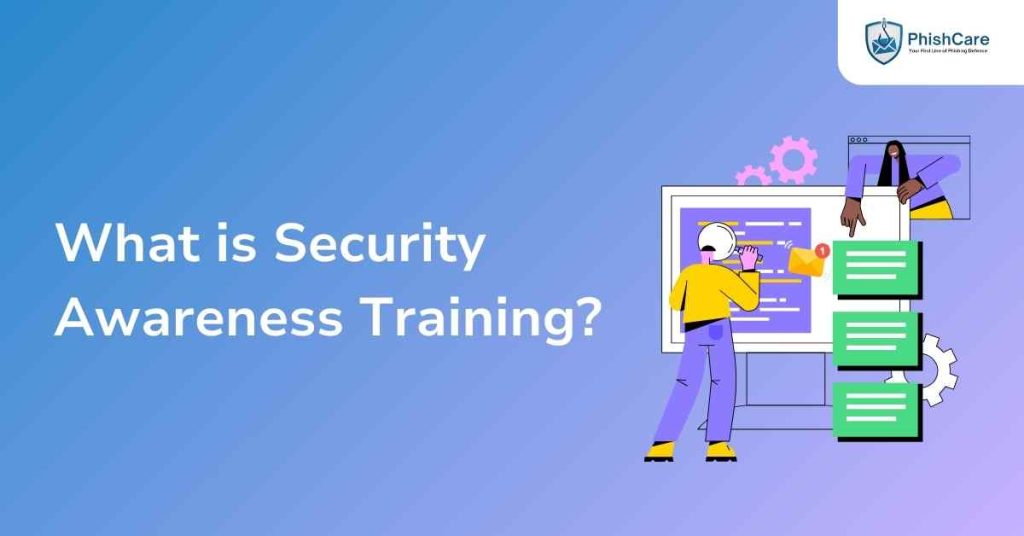Technology permeates every aspect of our lives, security concerns have become a paramount issue for individuals and organizations alike. Cyber threats are increasing in number and sophistication, making it essential for both employees and businesses to be well-informed about security practices.
This is where Security Awareness Training (SAT) comes into play. Understanding what is security awareness training entails, its importance, the components of an effective program, and best practices for implementation can significantly enhance an organization’s defense against cyber threats.
How Does PhishCare Conduct Security Awareness Training?
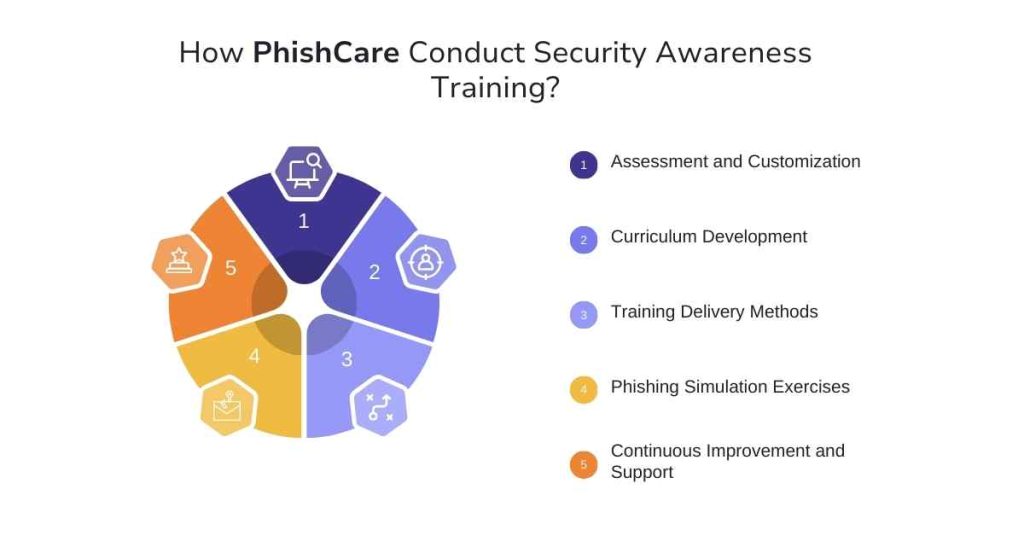
PhishCare conducts security awareness training using a comprehensive and structured approach. This is designed to educate employees about cybersecurity threats and best practices. Here’s an overview of the methods and strategies they likely employ:
1. Needs Assessment and Customization
Initial Consultation: PhishCare begins by consulting with organizations to understand their specific security needs, industry requirements, and the current security culture. This step helps tailor the training programs to the organization’s unique environment.
Risk Assessment: Conducting an assessment to identify potential vulnerabilities and threats specific to the organization ensures that the training focuses on relevant issues.
2. Curriculum Development
Comprehensive Training Modules: The training curriculum typically includes a wide range of topics, such as:
- Phishing Awareness: Techniques to recognize and report phishing attempts.
- Password Security: Best practices for creating and managing strong passwords.
- Social Engineering: Understanding tactics used by attackers to manipulate individuals.
- Data Protection: Safeguarding sensitive information and understanding data privacy regulations.
3. Training Delivery Methods
- E-learning Modules: PhishCare likely provides online training modules that employees can complete at their own pace. These modules may include interactive elements like quizzes and simulations to reinforce learning.
- Live Training Sessions: Offering live webinars or in-person sessions led by cybersecurity experts allows for real-time interaction, questions, and discussions.
- Microlearning: Breaking training into short, focused segments makes it easier for employees to absorb information and promote continuous learning.
Why PhishCare is the Best Phishing Simulation Tool for Security Awareness Training!

- Customizable Templates
- Awareness Module
- Assessment Test
- Comprehensive Tracking
- Graphical Dashboard Access
- Campaign Report
- Custom Domain Integration
4. Phishing Simulation Exercises
- Realistic Simulations: Conducting simulated phishing attacks helps employees practice recognizing and responding to phishing attempts in a controlled environment.
- Automated Campaigns: Regular phishing simulations allow for ongoing assessment of employee awareness and preparedness.
- Reporting and Analytics: Providing detailed reports on simulation results helps organizations identify employees who may need additional training. Metrics include click rates, reporting rates, and overall performance.
5. Continuous Improvement and Support
- Feedback Mechanisms: Incorporating feedback from participants post-training enables continual improvement of the training content and delivery methods.
- Regular Updates: Keeping training content up to date with the latest cyber threats, trends, and regulatory changes is essential.
- Ongoing Training: Establishing a culture of continuous learning through regular refresher courses and updates ensures that security awareness remains a priority.
The Importance of Security Awareness Training
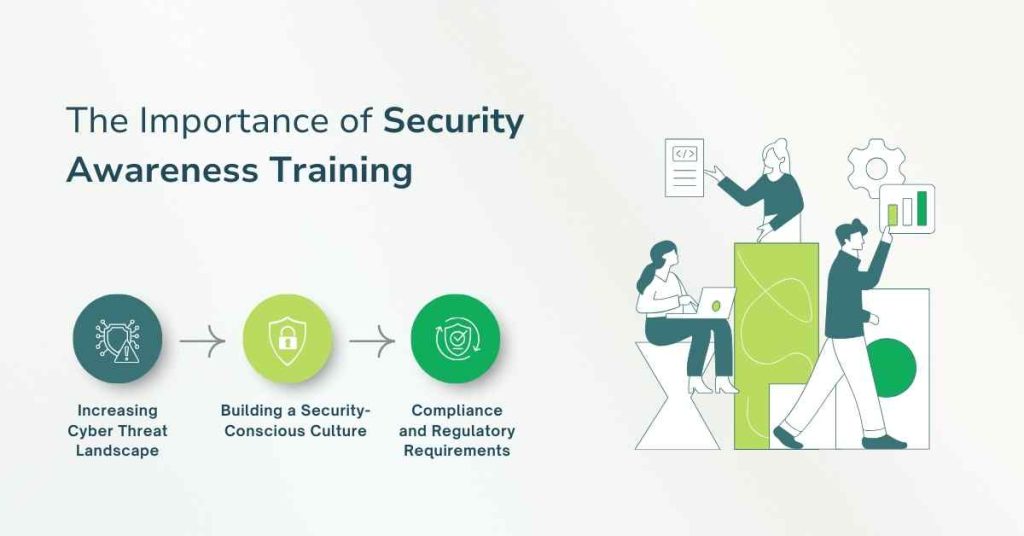
1. Increasing Cyber Threat Landscape
The digital age has brought upon an explosion of data and an increase in cyber attacks. According to cybersecurity reports, there is a new attack every 39 seconds on average, and 43% of these attacks target small businesses. Hackers employ various techniques, including phishing, ransomware, and social engineering, to exploit human vulnerabilities.
Given that the human element is often the weakest link in an organization’s security, the importance of SAT cannot be overstated. High-profile breaches, such as those experienced by major corporations, often begin with a simple phishing email that tricks an unsuspecting employee.
2. Building a Security-Conscious Culture
SAT fosters a proactive approach to security within an organization. When employees are educated about security risks and best practices, they become more vigilant and aware of their responsibilities regarding data protection. This cultural shift leads to collective ownership of cybersecurity efforts, where everyone collaborates to maintain security.
3. Compliance and Regulatory Requirements
Many industries have regulatory requirements that mandate employee training on cybersecurity awareness. For instance, the Health Insurance Portability and Accountability Act (HIPAA) requires healthcare organizations to train employees on protecting sensitive patient information. Non-compliance not only exposes organizations to potential breaches but can also lead to hefty fines and legal repercussions.
Components of Effective Security Awareness Training
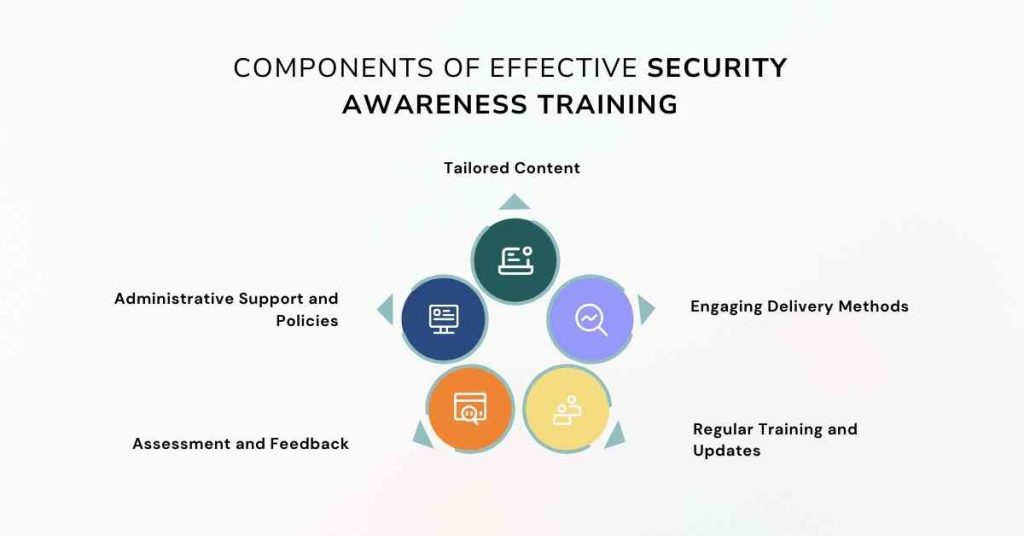
To maximize the effectiveness of SAT, organizations need to incorporate several key components:
1. Tailored Content
One size doesn’t fit all when it comes to training. An effective SAT program must be tailored to fit the specific needs of the organization and its employees. Different departments may encounter different security risks, so it’s important that the training addresses relevant scenarios.
2. Engaging Delivery Methods
Traditional methods of training, such as monotonous presentations, are often ineffective. Utilizing a mix of engagement techniques, such as interactive workshops, gamified learning modules, videos, and real-life scenarios, can enhance retention and understanding of complex topics.
3. Regular Training and Updates
Cyber threats are ever-evolving, so it is crucial that training is not a one-time event. Regular refreshers and updates keep security at the forefront of employees’ minds. Many organizations adopt an annual training schedule, supplemented by ongoing briefings about emerging threats.
4. Assessment and Feedback
Assessing employees’ understanding of the training material is vital to measure the program’s effectiveness. Organizations can utilize quizzes, surveys, and simulated phishing attacks to gauge employees’ knowledge and identify areas that require further training. This feedback loop can help refine and enhance the program over time.
5. Administrative Support and Policies
For SAT to succeed, it must be supported by robust security policies backed by organizational leadership. These policies provide a framework for expected behaviors and practices, ensuring employees understand the importance of adhering to security protocols.
Common Topics Covered in Security Awareness Training
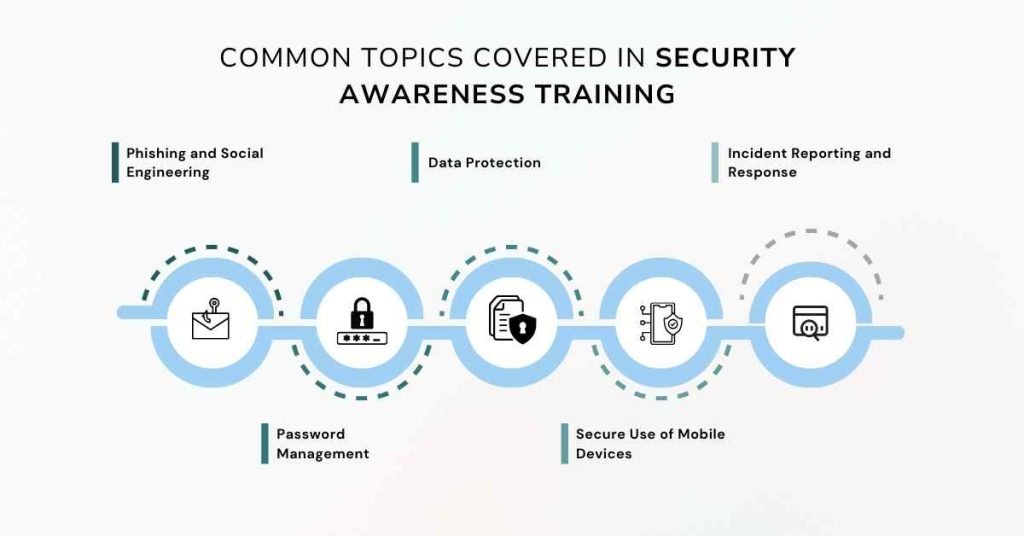
1. Phishing and Social Engineering
Phishing remains one of the most common tactics employed by attackers. Training that emphasizes recognizing suspicious emails, understanding how to handle unknown links, and reporting potential phishing attempts is crucial. Social engineering, which manipulates individuals into divulging confidential information, is also a prevalent theme in SAT.
2. Password Management
Strong password practices are fundamental to cybersecurity. Training should cover the importance of creating complex passwords, utilizing password managers, and the dangers of reusing passwords across multiple accounts.
3. Data Protection
Employees should learn about the importance of data integrity and the steps they need to take to protect sensitive information, including encryption, secure file sharing practices, and compliance with data protection regulations.
4. Secure Use of Mobile Devices
As remote work becomes increasingly common, training on the secure use of mobile devices is essential. Employees must understand how to protect company data on smartphones, tablets, and laptops, especially when connecting through unsecured networks.
5. Incident Reporting and Response
A critical component of SAT is educating employees on what to do in the event of a security incident. Training should include how to recognize an incident, whom to contact, and the importance of timely reporting to mitigate damage.
Best Practices for Implementing Security Awareness Training
1. Start with a Risk Assessment
Before rolling out a training program, organizations should conduct a comprehensive risk assessment to identify their unique vulnerabilities and the types of threats they face. This analysis will inform the content and focus of the training sessions.
2. Involve Employees in the Development Process
Engaging employees in the development of the training program can foster a sense of ownership and increase buy-in. Gathering input from various departments can ensure that the training is relevant and useful.
3. Leverage Real-Life Examples
Following up training sessions with real-life examples of security incidents, particularly those that have occurred within the organization or industry, can reinforce the importance of security awareness. These stories demonstrate the potential consequences of neglecting security practices.
4. Foster Open Communication
Encourage an environment where employees feel comfortable discussing security concerns or reporting suspicious activity without fear of reprimand. Open communication helps to create a culture of trust and encourages proactive participation.
5. Evaluate and Update Regularly
Since threats continuously evolve, organizations should regularly review and update their training materials and policies to keep pace with the changing landscape. Staying current with the latest security trends is essential for maintaining a robust defense.
Conclusion
In an age where cybersecurity threats are omnipresent and constantly evolving, Security Awareness Training has become more crucial than ever. It equips employees with the knowledge and skills necessary to recognize and respond to security threats effectively.
By investing in a comprehensive SAT program, organizations protect not only their sensitive information but also their reputation and stability. As technology continues to advance, fostering a security-conscious culture through ongoing education will be essential in navigating the complexities of today’s cyber landscape.
FAQs: What is Security Awareness Training?
1. Why is Security Awareness Training important?
Answer: Security Awareness Training is crucial because it helps reduce the risk of cyber threats, such as phishing attacks or data breaches. Educated employees can recognize and respond to suspicious activity, making them the first line of defense against potential attacks. Additionally, training is often a regulatory requirement within certain industries.
2. What topics are typically covered in Security Awareness Training?
Answer: Common topics in SAT include phishing and social engineering, password management, data protection, secure use of mobile devices, incident reporting and response, and the importance of following organizational security policies.
3. How often should Security Awareness Training be conducted?
Answer: Training should ideally be conducted regularly, with initial training upon hiring and follow-up sessions at least once a year. Organizations should also provide updates whenever new threats emerge or policies change.
4. What methods are effective for delivering Security Awareness Training?
Answer: Effective delivery methods include a combination of interactive workshops, e-learning modules, video presentations, and real-life case studies. Utilizing gamification techniques can also enhance engagement and retention of information.
5. How can employers assess the effectiveness of Security Awareness Training?
Answer: Employers can assess the effectiveness of SAT through quizzes, surveys, and simulated phishing tests to evaluate employees’ knowledge and understanding of security practices. Regular feedback and performance metrics can help refine the training program.
6. What should employees do if they suspect a security incident?
Answer: Employees should be trained to report any suspicious activity or potential security incidents immediately to their organization’s IT department or designated security personnel. Quick reporting can help mitigate any potential damage from a security breach.
7. How can organizations create a culture of security awareness?
Answer: Organizations can foster a culture of security awareness by promoting open communication about security issues, involving employees in the development of training programs, and encouraging proactive participation through regular training and updates. Recognition and rewards for safe practices can also reinforce this culture.
8. Are there any compliance requirements for Security Awareness Training?
Answer: Yes, many industries have compliance requirements regarding cybersecurity training. For example, healthcare organizations must comply with HIPAA regulations, while financial institutions may be subject to regulations from the Gramm-Leach-Bliley Act (GLBA). Organizations should ensure their training programs meet applicable legal requirements.
9. Can Security Awareness Training prevent all cyber threats?
Answer: While Security Awareness Training significantly reduces the risk of cyber threats by educating employees, it cannot guarantee complete prevention. A comprehensive security strategy should also include technical defenses, policies, and incident response plans to effectively mitigate potential risks.

